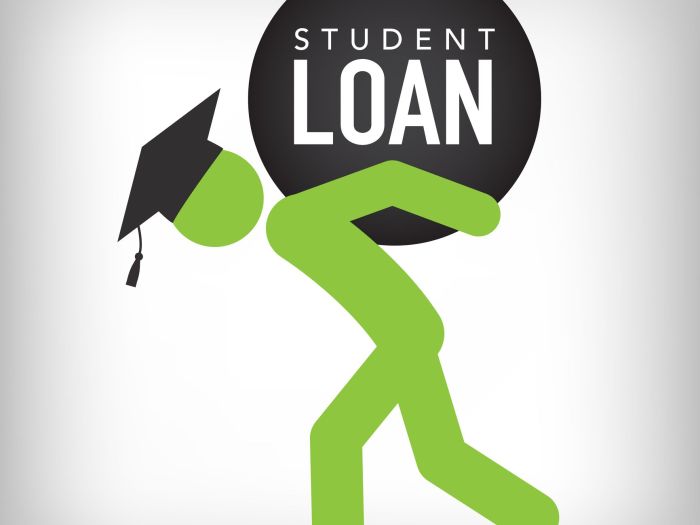
Navigating the complexities of student loan debt can feel overwhelming, but understanding the options available can empower you to take control of your financial future. Student loan consolidation offers a potential pathway to simplify repayment, potentially lowering monthly payments and streamlining the process. This guide explores the intricacies of student loan consolidation, providing a clear understanding of its benefits, drawbacks, and eligibility requirements to help you make informed decisions.
We’ll delve into the different types of consolidation programs – federal and private – examining their respective advantages and disadvantages. We will also cover crucial aspects such as interest rates, repayment plans, and the necessary steps to apply for consolidation. By the end, you’ll have a comprehensive understanding of whether consolidation is the right strategy for your unique financial situation.
Finding the Right Consolidation Program

Choosing the right student loan consolidation program is crucial for effectively managing your debt and achieving long-term financial health. A well-chosen program can simplify repayment, potentially lower your monthly payments, and offer a clearer path to becoming debt-free. However, a poorly chosen program can lead to unexpected fees, higher interest rates, or even worse financial situations. Careful consideration of several key factors is essential.
Factors to Consider When Choosing a Consolidation Program
Several key factors influence the suitability of a student loan consolidation program. These include interest rates, fees, repayment terms, and the lender’s reputation and customer service. Understanding these aspects helps borrowers make informed decisions aligned with their financial goals. Ignoring these factors can lead to unforeseen consequences.
- Interest Rate: The interest rate directly impacts the total cost of your loan. Compare fixed vs. variable rates and look for the lowest possible rate that aligns with your risk tolerance. A lower rate will save you money over the life of the loan.
- Fees: Many lenders charge origination fees or other processing fees. These fees can add significantly to the overall cost. Carefully review all fees associated with the program before committing.
- Repayment Terms: Consider the length of the repayment period. A longer repayment term will result in lower monthly payments, but you’ll pay more in interest over time. A shorter term means higher monthly payments but less interest paid overall. Balance your budget with long-term financial goals.
- Lender Reputation and Customer Service: Research the lender’s reputation. Check online reviews and ratings from reputable sources like the Better Business Bureau. Excellent customer service is crucial for addressing any issues or questions that may arise during the repayment process.
Decision-Making Flowchart for Consolidation Program Selection
A systematic approach to choosing a consolidation program can significantly improve the outcome. The following flowchart illustrates a step-by-step process:
[Imagine a flowchart here. The flowchart would begin with “Start,” then branch to “Assess your current debt,” leading to “Compare lenders based on interest rates, fees, and repayment terms,” then “Check lender reputation and customer service,” then “Compare offers,” then “Choose best option,” and finally “Complete application.” Each step would have clear yes/no or decision points where appropriate. This visual aid would simplify the decision-making process for borrowers.]
Comparison of Services Offered by Different Lenders
Different lenders offer varying services, impacting the borrower experience. For instance, some lenders may provide online account management tools, automated payment options, or financial counseling resources. Others might offer more personalized service, including phone support or dedicated account managers. These differences can significantly affect the overall convenience and support received.
| Lender | Interest Rate (Example) | Fees (Example) | Repayment Options | Customer Service Features |
|---|---|---|---|---|
| Lender A | 4.5% Fixed | $100 Origination Fee | Fixed Term, Variable Term | Online Account Management, Phone Support |
| Lender B | 5.0% Variable | $0 Origination Fee | Fixed Term Only | Online Account Management Only |
| Lender C | 4.8% Fixed | $50 Origination Fee | Fixed Term, Income-Driven Repayment | Phone Support, Financial Counseling |
*(Note: These are example rates and fees and may not reflect current market conditions. Always check directly with the lender for the most up-to-date information.)*
Red Flags to Watch Out for When Dealing with Lenders
Be wary of lenders who promise unrealistically low interest rates or fees, pressure you into making quick decisions, or have unclear or hidden fees. These are common red flags indicating potentially predatory lending practices. Thorough research and careful review of all documents are crucial to avoid scams.
- Unusually Low Interest Rates: Be skeptical of rates significantly lower than those offered by reputable lenders.
- High-Pressure Sales Tactics: Legitimate lenders will not pressure you into making a decision before you’re ready.
- Unclear or Hidden Fees: Carefully review all fees and terms before signing any documents.
- Lack of Transparency: If the lender is unwilling to answer your questions or provide clear explanations, it’s a warning sign.
Resources for Finding Reputable Lenders and Programs
Several resources can help you find reputable lenders and consolidation programs. These include government websites, non-profit organizations, and independent financial advisors. Utilizing these resources can enhance the chances of finding a suitable and trustworthy program.
- Federal Student Aid (FSA): The FSA website offers information on federal student loan consolidation programs.
- National Foundation for Credit Counseling (NFCC): The NFCC is a non-profit organization that provides credit counseling and debt management services.
- Independent Financial Advisors: A financial advisor can provide personalized guidance on choosing the right consolidation program.
Illustrative Examples

Understanding the nuances of student loan consolidation and refinancing requires examining specific scenarios. The following examples highlight the potential benefits and drawbacks, helping you make informed decisions about your student loan debt.
Consolidating Federal Student Loans: A Beneficial Scenario
Imagine Sarah, a recent graduate with $60,000 in federal student loans spread across three different loan programs—subsidized, unsubsidized, and a Grad PLUS loan—each with varying interest rates (4%, 6%, and 7% respectively). Managing these loans separately is cumbersome, requiring her to track multiple due dates and payment amounts. By consolidating her federal loans into a single Direct Consolidation Loan, Sarah simplifies her repayment process. While her interest rate may be a weighted average of her previous rates (let’s say 5.5%), the convenience and streamlined payment process significantly improve her financial management. She can also potentially qualify for an income-driven repayment plan, lowering her monthly payments based on her income and family size. This offers significant relief and improved long-term financial planning.
Consolidating Private Student Loans: A Potential Drawback
Consider David, who has $40,000 in private student loans from three different lenders, each with varying interest rates and terms. He considers consolidating these loans with a single private lender, lured by a lower initial interest rate. However, this consolidation comes with a longer repayment term, stretching his payments over 20 years instead of the original 10-year plans. While his monthly payment is lower, he ends up paying significantly more interest over the life of the loan. Furthermore, he loses any potential benefits or protections associated with his original loans, such as deferment options or hardship programs. This longer repayment period, coupled with the additional interest, increases his total loan cost substantially, potentially outweighing the benefits of a lower monthly payment.
Refinancing vs. Consolidation: A Superior Alternative
Let’s examine Maria’s situation. She has a strong credit score and a stable, high-income job. She has a mix of federal and private student loans. Consolidating these loans wouldn’t necessarily provide her with a lower interest rate, especially since she’s eligible for better terms on the private loans. Instead, refinancing her loans with a private lender allows her to secure a significantly lower interest rate than what she currently has on her private loans, substantially reducing her overall loan cost and potentially shortening her repayment timeline. This scenario demonstrates that refinancing can be a superior strategy compared to consolidation when borrowers have strong credit and favorable financial circumstances.
Financial Impact of Longer vs. Shorter Repayment Plans
Choosing between a longer and shorter repayment plan significantly impacts your overall loan cost. Consider the following:
- Longer Repayment Plan (e.g., 20 years): Lower monthly payments, but significantly higher total interest paid over the life of the loan. This can lead to a much larger overall debt burden. For example, a $30,000 loan at 6% interest over 20 years could result in paying more than $15,000 in interest.
- Shorter Repayment Plan (e.g., 10 years): Higher monthly payments, but substantially lower total interest paid. This can lead to significant long-term savings and faster debt payoff. Using the same $30,000 loan at 6% interest, a 10-year plan might result in approximately $7,000 in interest.
The choice depends on individual financial circumstances and risk tolerance. A longer plan offers immediate affordability but delays financial freedom. A shorter plan demands greater financial discipline upfront but accelerates debt elimination and minimizes long-term costs.
Ultimate Conclusion

Successfully navigating student loan debt requires careful planning and a thorough understanding of available options. Student loan consolidation presents a viable solution for many, offering the potential for simplified repayment and potentially reduced monthly payments. However, it’s crucial to weigh the potential benefits against the potential drawbacks, such as potentially higher overall interest paid, and to carefully consider your individual circumstances. By understanding the intricacies of different consolidation programs and making informed decisions, you can pave the way towards a more manageable and financially secure future.
Helpful Answers
What is the difference between federal and private loan consolidation?
Federal consolidation combines your federal student loans into a single loan with the government. Private consolidation combines federal and/or private loans through a private lender, often with different terms and conditions.
Will consolidating my loans affect my credit score?
Consolidating federal loans typically has minimal impact. Private consolidation may temporarily lower your score due to a hard inquiry, but responsible repayment can improve it over time.
Can I consolidate loans if I’m currently in default?
Federal loan consolidation may be an option to rehabilitate defaulted loans, but it’s crucial to contact your loan servicer to understand the specific requirements.
What happens to my loan forgiveness programs after consolidation?
This depends on the type of consolidation. Federal consolidation generally preserves eligibility for income-driven repayment plans and forgiveness programs, but it’s essential to confirm this with your servicer.
